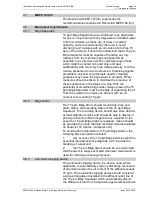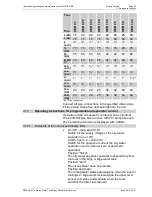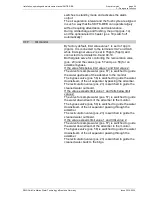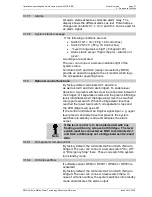
Installation, operating and maintenance manual SKIT/S-DEB
3rd print version
page 18
3 – Design and function
RWO GmbH
●
Marine Water Technology
●
Bremen
●
Germany
Issue 2014-04-10
small oil particles which, however, do not form larger
drops or connect to such. Generating an emulsion
requires mechanical energy. This can be achieved by a
rotary pump or by higher pressure and turbulent flow
speed in a pipe system. In this process, present oil drops
are divided into many very small oil particles. This type of
mechanical emulsion can easily be separated by means of
an efficient coalescer. But if emulsifying chemicals are
present, the oil particles become hydrophobe by means of
ionic and anionic tensides on the oil particle surface. The
same micro-electric load of all particles in a stable
chemical emulsion renders agglomeration impossible.
Mechanic emulsions can normally be easily separated by
means of a mechanic coalescer. However, this does not
refer to stable chemical emulsions which can be separated
by means of:
·
heat treatment in a vaporiser
·
chemical processes by using an adequate
coagulation agent
·
membrane - ultrafiltration which retains the oil
molecules
·
adsorption by means of suitable materials
3.4
Excerpt from the IMO Resolution MEPC.107(49)
Excerpt from the IMO Resolution MEPC.107(49)
The following contains an excerpt from the IMO Resolution
MEPC. 107 (49). The excerpts are quoted in the original
language (English).
Revised Guidelines and Specification for Pollution
Prevention Equipment for Machinery Space Bilges of
Ships: Background
3.5
MARPOL 73/78 Annex I
The requirements of Annex I of the International
Convention for Prevention of Pollution from ships
MARPOL 73/78 relating to pollution prevention equipment
for ships are set out in regulation 16, which stipulates that
shops of 400 gross tonnage and above should be installed
with approved equipment
3.6
Regulation 16 (5)
Regulation 16(5) stipulates that the oil content of the 15
ppm Bilge Separators should not exceed 15 ppm. The 15
ppm Bilge Alarm shall activate to indicate when this level
cannot be maintained and initiate automatic stop of
overboard discharge of oily mixtures where applicable.
3.8.1
15 ppm Bilge Separator;
3.8.2
15 ppm Bilge Alarm
3.8.3
Automatic stopping device
















































